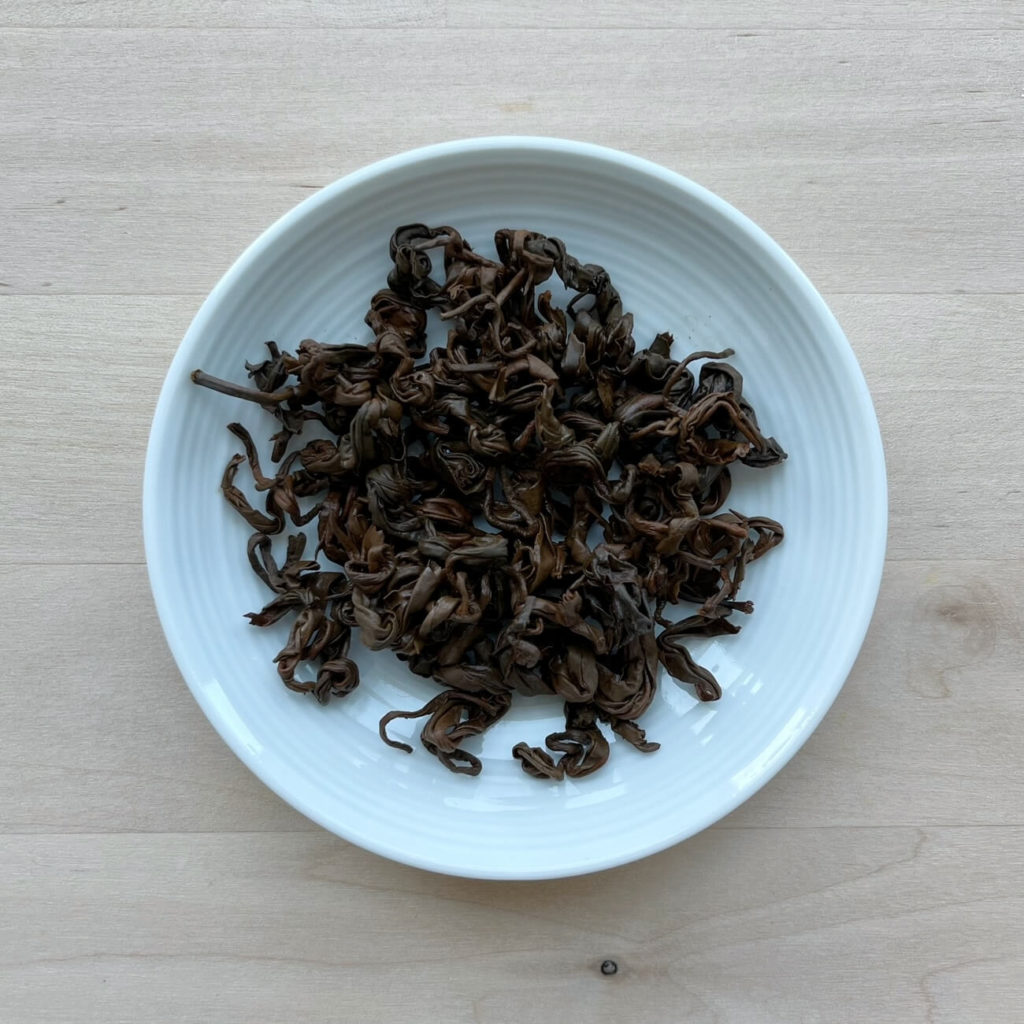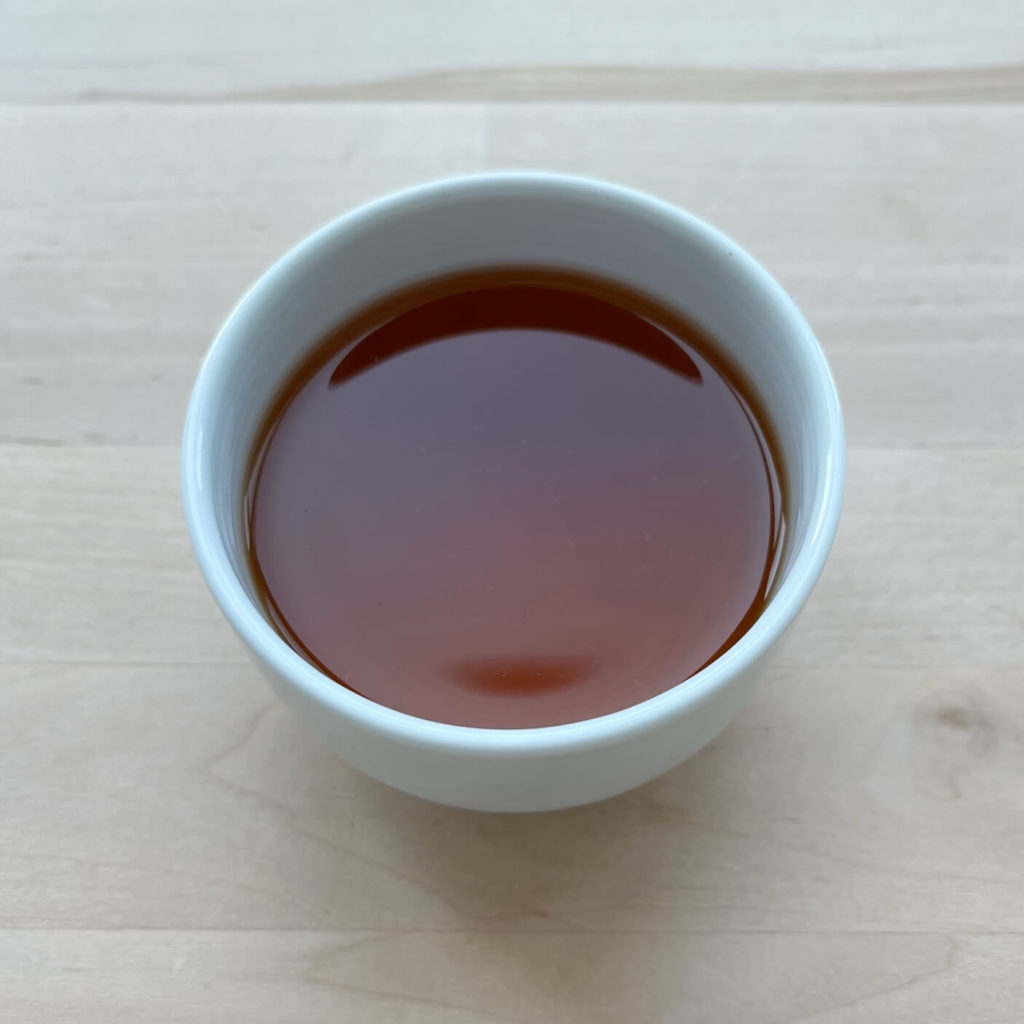
Last week, I tried a green tea from the same producer, M. Qi, from Guizhou, China. Whenever the opportunity presents itself, I always like to taste more than one tea from a producer to see the similarities and differences!
Description: “Its crisp finish presents delicate notes of stewed berries and even a subtle floral touch.”
Instructions: 5 grams | 95°C (203° F) | Infusion 1 (10 seconds), Infusion 2 (10 seconds), Infusion 3 (15 seconds)
Review: Like the green tea, this black tea is also a Fuding Da Bai cultivar and was grown at 1,200 meters above sea level. The dark greenish-brown, almost black, dry leaves were small and tightly rolled into pearls like green tea and did not have a strong smell. Camellia Sinensis’ website had two options on how to brew – Gong Fu Style (using a gaiwan) and Western with a teapot, but I used a cup instead.
Gong Fu Style (Gaiwan):

Pre-warmed gaiwan: Warming the dry leaves brought out a freshly baked bread and berries smell.
Infusion 1 (10 seconds): Once the quick flash infusion was done, the liquor had already picked up a reddish-brown colour. It tasted roasted, fruity, and malty, like baked goods. The cooled liquor caused dryness at the back of the throat.
Infusion 2 (10 seconds): The taste profile was more woody and earthy with hints of grain and sweetness at the end of the sip and dryness at the back of the throat. The bready taste stayed and lingered in the mouth.
Infusion 3 (15 seconds): Liquor had become a dark reddish brown with a woody and date flavour and less predominate bread taste.

Wet leaves: The wet dark brown leaves were twisted and had not fully unfurled. It smelled mineral and woody.
I tasted this tea with the recommended 5 grams, but also 4 grams to have a fair comparison to the green tea from the same producer. Since there was less tea, the flavour was not as complex as with 5 grams but still had the same taste profile. With 5 grams, I enjoyed the first infusion best and with 4 grams, I enjoyed the second as it had a well round taste of sweet and bready.
Western Style (Cup):

After 4 and a half mins, the liquor was a dark reddish brown. The taste went from sweet to baked bread with notes of malt, barley, honey and some dryness at the back of the throat. The wet leaves smelled malt, sweet, and like berries.
Cold Brew:
Since it has been very warm in my area, I was craving a cold brew tea. I brewed with fresh and prior infused tea leaves (from the tastings above) as I didn’t want the tea to go to waste. I let the tea steep in the fridge for over 12 hours.
- With the fresh tea, I used 1 cup of water to 5 grams of tea. It developed into a chocolaty, sweet, malty, and pastry flavour.
- For the spent leaves, I used 1/2 a cup of water to 4 grams of tea. Despite the leaves having already been infused 3 times, it still had a lovely sweet malty taste!
Turning the tea into a cold brew brought out more of a sweet malty note than the baked bread flavour of the Gong Fu or Western-style forms of brewing.
Overall:
I have become a big fan of Chinese black teas that lean more sweet, malty, and bread-like in taste, so this one was a huge win for me. I liked that I was able to try it in various methods and still had the sweetness come through. I enjoyed it best gong fu style, since it had more flavours, or as a cold brew during these warmer days. This would be a nice tea for people who like Chinese black teas, or sweeter black teas. This would make a lovely afternoon sip during afternoon tea and eating scones (4/5 rating).
- Type: Black tea
- Origin: China, Guizhou
- Caffeine: Unknown
- Ingredients: Black tea
- Company: Camellia Sinensis Tea House
The question of the post: Do you like sweeter or more bitter black teas
Liked this review of Camellia Sinensis Tea House’ Dejiang Hong Cha? Pin it!

